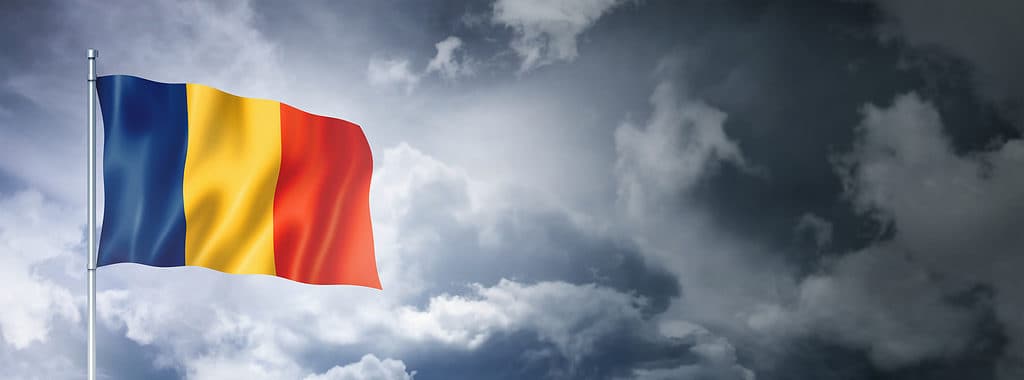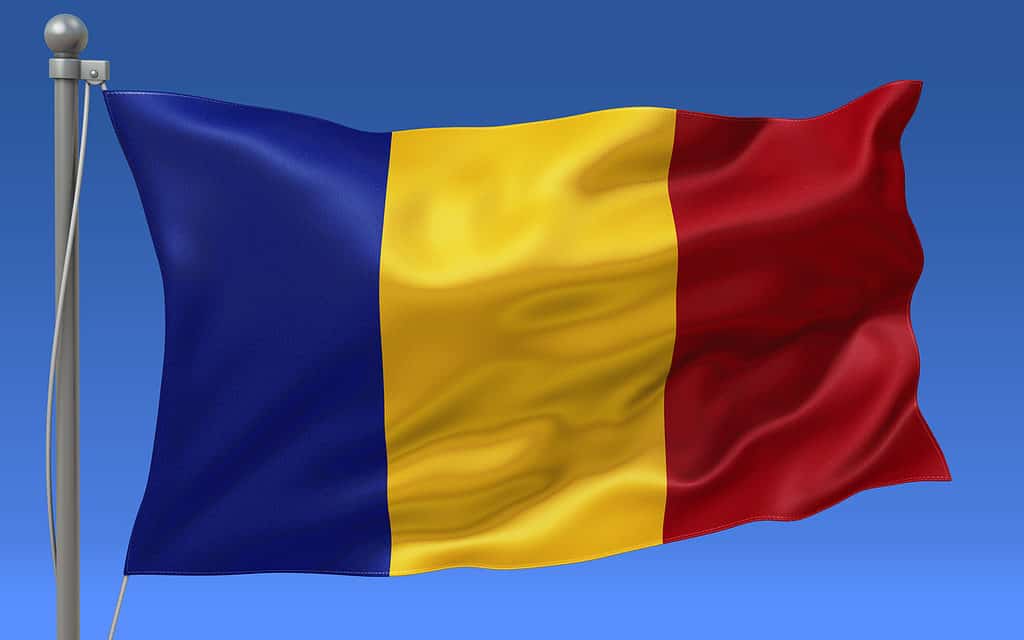Chad, a landlocked country in north-central Africa, is named after the River Chad, Africa’s second-biggest river and Chad’s largest wetland. An essential lifeline for Chadians, the river has devastatingly shrunk by 90% since the 1960s. Flanking Chad is Libya in the north, Sudan in the east, and the Central African Republic in the south.
Chad is the fifth-largest state and the most ethnically diverse place in Africa. With over 200 ethnic groups and 100 spoken languages, Chad has been crowned The Babel Tower of the world.
Perhaps due to its vast diversity, post-colonial Chad has struggled to unify. Its deep-rooted divide between the north and south of the country threatens its stability with endless conflict and a stream of civil wars.
Though Chad’s history has been turbulent, its flag hasn’t changed since becoming independent. The vertical tricolor flag combines the French flag’s design with the Pan-African colors. While practical, the flag is also profoundly symbolic and meaningful.
In this article, you will learn about Chad’s origins and turbulent past and how its flag design came about.
Short History of Chad
Chad has a long, steeped history. Archeological evidence suggests that humans have lived in Chad since ancient times when the arid terrain of the northern Sahara was once fertile and filled with water. Additionally, the Sao civilization flourished, farming and fishing for thousands of years around Lake Chari, south of Lake Chad.
Later in history, Chad served an essential purpose, especially from the 14th to the 19th century. Not only did various indigenous groups live there, but it was a traveling route for Muslims and Arab migrants who brought Islam to Chad (the exact timing of this is debatable).
Marking this historical period was fighting between competing kingdoms (Baguirmi and the pre-Islamic state of Kanem-Bornu), chiefdoms, and sultanates. Slavery and Arab slave raids were also common in this era. The practice escalated in the mid-17th century as the Baguirmi Empire became an important source of slaves for the trans-Saharan trade.
Characteristics of Chad

Chad’s three official languages are French, Arabic, and Sara.
©iStock.com/HomoCosmicos
Chad is home to several ethnicities, cultures, religions, languages, and about 17 million people.
What fascinates people about Chad is that it’s a linguistic minefield. We don’t know how many languages there are, but the number’s over 100.
Chadian languages are split over 12 groupings scattered within different locations. The largest is Sara-Bongo-Bagirmi, which represents the languages of one million people in central and southern Chad. The Mundang-Tuburi-Mbum has the second most extensive collection of languages, spoken by several hundred thousand people in southwestern Chad. The other groupings account for the various dialects spread across different regions.
Despite the numerous dialects sweeping the country, Chad’s three official languages are French, Arabic, and Sara. Chad’s version of Arabic, Chadiac Arabic, the chosen tongue of 1.6 million people, is widespread.
Three-fifths of Chad is Sunni Muslim – which is unsurprising, given that Islamization has been around for a long time. Most Muslims are native to the north and east of the country. Meanwhile, animists make up one-fifth of the population. They inhabit the country’s southern parts and the mountainous region of Guera. Less than one-fifth of Chadians are Christians, either belonging to Roman Catholic or protestant denominations.
French Colonization of Chad
Not many people welcomed France into Chad, but victims of slave raiding hoped their presence would end the inhumane practice. Colonial French rule marked the downfall of the notorious Sudanese warlord and slave raider Rabih az-Zubayr, who was killed in a colonial battle.
From 1900, Chad fell under French colonial rule, along with other French colonies – present-day Gabon, Central African Republic, and Congo (Brazzaville). Together these territories formed French Equatorial Africa.
Although the French colonial powers eradicated slavery successfully, they enforced a different form of exploitation. The colonial system in Chad favored the resource-rich south, oppressed the north, and ultimately polarized the two sides. The consequences of this regime caused significant issues later once colonization ended.
When French Equatorial Africa disbanded in 1959, Chad and the other mentioned states became autonomous. Chad gained complete independence one year later, governed by its first president, Francois Tombalbaye, a Christian southerner.
Conflict between the Arab Muslims of the north and the Sub-Saharan Christians of the south scarred the country. This divide emerged during colonization and amplified after Chad’s independence.
Tombalbaye’s Sara government, marked by repression, favoritism, and corruption, heightened tensions and discontentment, especially among the non-Sara Muslim population. This antagonism would eventually result in a bloody Chadian civil war in 1965 that continued throughout the 60s and 70s.
The unrest has continued unabated for years, ignited by different perceptions to rule the country and leaders shifting back and forth between Christian southerners and Arab northerners. The most recent Chadian civil war began in 2005 and lasted five years.
The reason for the violence is complicated. However, it essentially derives from unfamiliar colonial structures left behind. Simply put, multi-ethnic people, without affinity toward each other or a recognizable national identity, were suddenly bound together in a state.
The Symbolism of the Flag of Chad

The red color on the flag of Chad represents the blood spilled and the sacrifices made to gain independence.
©iStock.com/daboost
Chad’s flag flaunts a simple design incorporating three vertical stripes of blue, yellow, and red. The first version of the flag – green, yellow, and red – was adopted on the 6th of November, 1959, but was quickly changed because it looked like Mali’s flag.
After substituting the green band with a dark blue one, the flag design remained unchanged despite the country’s many ups and downs.
Simple yet highly symbolic, the flag blends France’s tricolor flag, reflecting its past colonial ties, with pan-African colors representing the future.
Each color in the flag symbolizes different things – the blue represents the sky and hope, the yellow embodies the sun and desert, and the red pays homage to the blood spilled and the sacrifices endured to achieve independence.
Why Is the Chad and Romania Flag the Same?

Chad’s flag closely resembles that of Romania.
©iStock.com/Nabil Kamara
Chad might have replaced its flag design once, but it won’t be making changes again, despite having a flag that closely matches the Romania flag. Compare them, and you’ll notice only subtle differences between the countries’ flags. These include slight variations of the shades and the Romanians’ narrower definitions of the colors.
The reason behind the flags’ sameness is that Romanians removed the Coat of Arms, which was once the distinguishing feature between the two, from the center of the flag in 1989 to mark an end to communism in the country.
Romania also won’t alter its flag choice either. In 2004, the then-president Ion Iliescu confirmed his country wouldn’t give up its flag, stating, “The tricolor belongs to us. We will not give up the tricolor.”
Up Next:
- The Flag Of Mexico: History, meaning, and symbolism
- Animals in Chad
- The Flag Of Sudan: History, meaning, and symbolism
The photo featured at the top of this post is © iStock.com/Cesare Ferrari
Sources
- , Available here: https://reliefweb.int/report/chad/tale-disappearing-lake
- , Available here: https://www.csusm.edu/bsc/pan-afflag.html#:~:text=Red%3A%20the%20blood%20that%20unites,wealth%20of%20Africa%2C%20the%20Motherland
- , Available here: https://books.google.co.cr/books?hl=en&lr=&id=-etHBAAAQBAJ&oi=fnd&pg=PA15&dq=slave+raiding+chad&ots=IQhacB4vV7&sig=_nrv4hznWsYtGfLJAPbLclSL4sk&redir_esc=y#v=onepage&q=slave%20raiding%20chad&f=false
- , Available here: https://www.refworld.org/docid/469f3878c.html
Thank you for reading! Have some feedback for us? Contact the AZ Animals editorial team.







